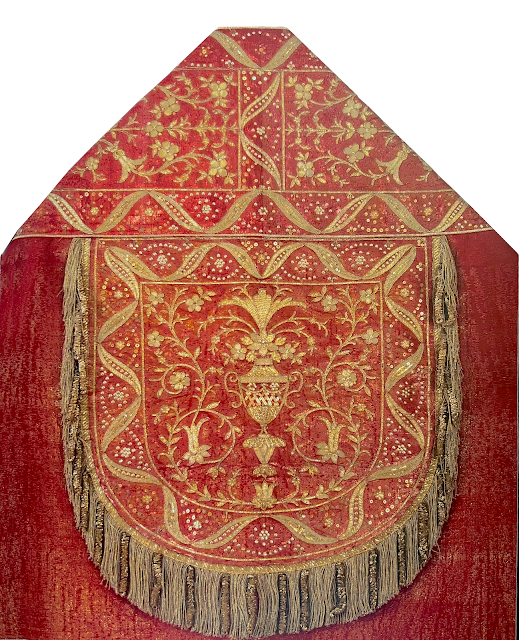In the year 2010, on the occasion of a Requiem Mass offered for Augustin Cardinal Mayer, OSB (a former prefect of the Congregation for Divine Worship and also a one time president of the Ecclesia Dei Commission), Pope Benedict XVI wore a stunningly beautiful red cope (as is the custom for papal mourning), embroidered in gold floriated designs, set on silk lamé. The vestment's dignity and beauty caught a great deal of attention at the time -- and still does now (for such is the timeless appeal and nature of beauty and nobility).
The cope in question is thought to come from the pontificate of Pope Pius VI. Pius VI reigned as supreme pontiff from 1775-1799. This particular pontiff condemned the French Revolution with its corresponding oppression of the Church in France. When Napoleon's troops conquered the papal states and Pius VI refused to cede his temporal authority to Napoleon, he was taken as a prisoner to France where he would die eighteen months later in the French city of Valence.
Prior to that unfortunate series of events, Pius VI sought to weed out corruption in the papal states and was a great promoter not only of the temporal good, but was also a great patron of the arts and the humanities.
Turning our attention back to the cope in question, it was part of a set that also included a chasuble and dalmatics. It was made in Rome with the silk lamé being produced either by Bartolomeo Chellucci or Giacomo Filippo Garbani. The embroidery of the vestments was executed by Filippo Salandri and Camilla Dormi.
The embroidered designs on the vestments show the influence of the French neoclassical tastes of the period, showing floral elements, garlands (festoons) and amphora vases within the design. A distinctive, snaking ribbon forms the embroidered galloons of the cope. The following present some better views of the cope itself as well as the chasuble that forms a part of the set. Unfortunately an image of the dalmatic has not been forthcoming, but one can readily imagine it based on the continuity of these designs.
-------
Do you like Liturgical Arts Journal's original content? You can help support LAJ in its mission and vision to promote beauty in Catholic worship either by:
You choose the amount! Your support makes all the difference.









_%E2%80%93_unframed.jpg)










